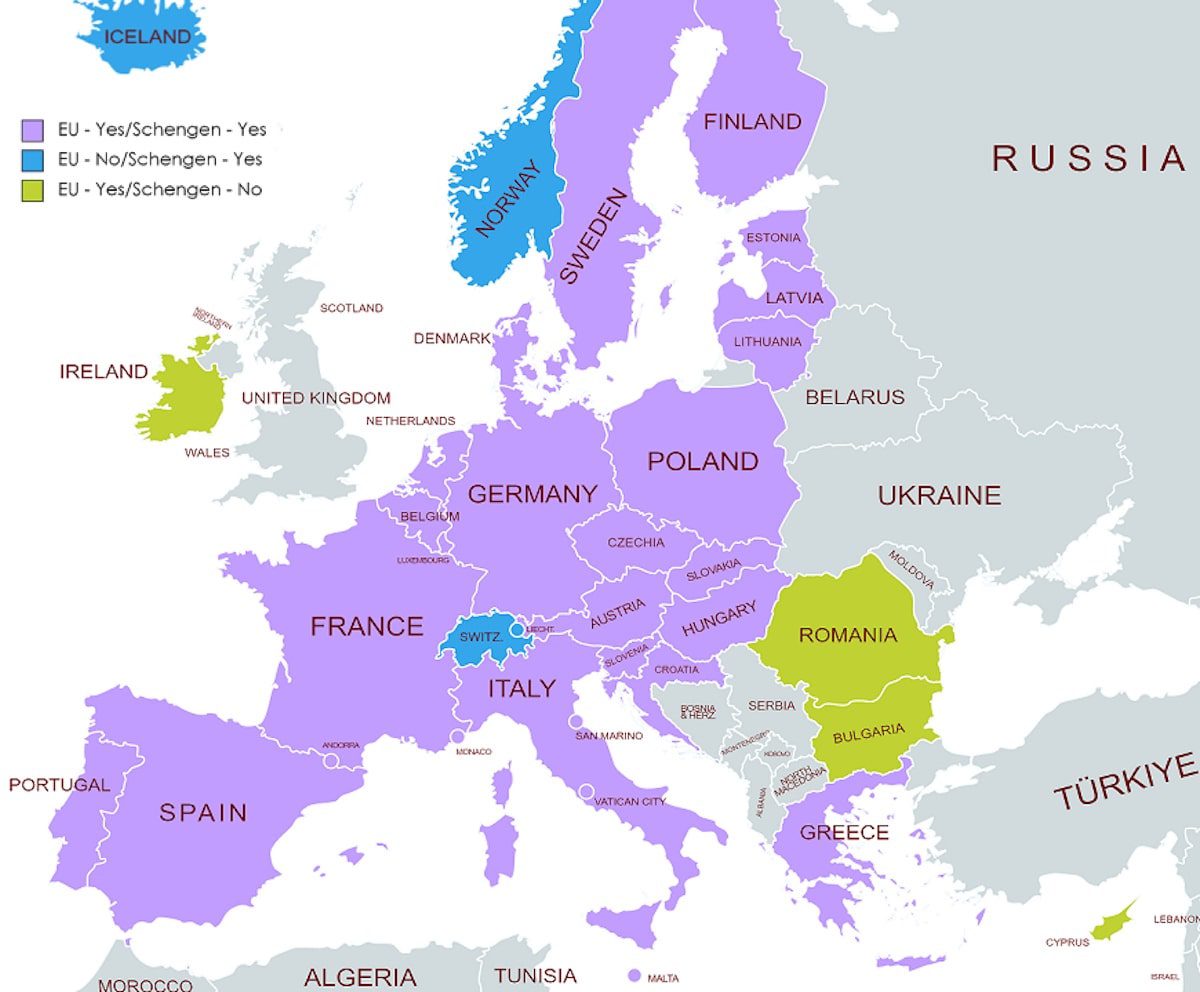Featured image: Heading to Europe? Learn about the upcoming ETIAS visa might affect you | Photo by seventyfourimages on Envato
Understanding the ETIAS, EES and the Schengen Zone
by Leyla Alyanak
Visiting Europe has often been a rite of passage, made easier by borderless travel, rail passes, and a 90-day unquestioned permission to stay.
Only 90 days? For some, that was simply not enough, so visitors became creative, finding loopholes that allowed them to overstay.
Some of these involved visiting a non-EU country for a few weeks, or simply ignoring the stamp in their passport and trying to sneak across one of the “less strict” borders along Europe’s southern periphery. There were heavy fines, even travel bans to Europe, but none of that mattered. For those desperate to extend their European trip, it was still worth a try – but soon it will no longer be. Once the Paris Olympic games are over, two new electronic surveillance schemes will make sure everyone leaves the EU on time, and that they have the right paperwork to boot.
The Entry/Exit System, or EES
The first of these is the EES, or Entry/Exit System. The colourful passport stamps we’ve grown to love and collect will be replaced by a biometric face scan and fingerprinting. So much for the romance of smudged ink on our passport pages, reminding us of our past adventures…
At first sight, this might not seem like a big deal – similar systems are already in place in many countries. But privacy is a growing concern, as is the increasing electronic oversight of every step we take.
According to the European Commission, the EU’s executive branch, “The system will register the person’s name, type of the travel document, biometric data (fingerprints and captured facial images) and the date and place of entry and exit, in full respect of fundamental rights and data protection.”
That last sentence sounds fine on paper, but as we know only too well, it’s not about the information but about how it’s used. In fairness, many European governments have been concerned about illegal immigration and about terrorism, so tightening up border controls is probably a logical step.
- If you are traveling to one of these 30 countries
- If you don’t at present need a visa to enter these countries
- If you’re not a citizen or permanent resident of one of these 30 countries
What the EES will do is wipe out any hope of an overstay. The computer will know to the minute when we entered, and when we are supposed to leave. And the computer is never wrong, right?
By keeping track of entries and exits electronically, outwitting the system will be as easy as winning a chess game against an app.
And then there’s a second system.
The European Travel Information and Authorization System or ETIAS
The European Travel Information and Authorization System, known as ETIAS, is expected within a few months of the EES. This is a different beast and will not be collecting any biometric data.
If you’ve ever entered the United States, you’ll be familiar with the ESTA, or the eTA in Canada, or ETA in Australia. The European version is similar – just another little door of freedom closing.
It won’t be hard to get an ETIAS if you come from a visa-exempt country (in other words, if you don’t need a visa to enter the EU). Once approved online, you’ll be set for three years – or until your passport expires, whichever comes first. At €7 per person, it’s not exactly expensive, and free for those under 18 or over 70.
While EES will apply to just about every non-European visitor crossing into Europe, ETIAS will only apply to citizens of visa-exempt countries. If you DO need a visa for the EU, that won’t change: you will still need one. It’s incredibly confusing, and even official websites have been known to contradict one another. In the end, we will have to wait until everything is actually in place before judging how the new procedures affect our travels.
You DON’T need to apply for an ETIAS:
- If you’re a citizen or legal resident of one of the 30 countries
- If you now require a visa to enter these countries (in which case the process doesn’t change – you’ll still require a visa)
While the changes are expected in late 2024, authorities have promised to be flexible. They won’t throw you in prison or deny you entry if you show up without an ETIAS – at least not during the first six months.
What about Schengen?
Named after a village on the borders of Luxemburg, France and Germany, the Schengen Agreement has allowed visitors to move freely among member countries. Once you’re in, you’re in. But we’ve had to grapple with two lists: the 27 (now 29) Schengen countries, and the 27 members of the European Union. The problem? The lists don’t match, making for even more confusion.

Map outlining the Schengen Area compared to the European Union, February 2024 / Map provided by schengenvisainfo.com via Wikimedia Commons
How will ETIAS and Schengen be different?
- Visitors to Europe who have an ETIAS will not need a Schengen visa
- Visitors who aren’t eligible for an ETIAS will need a Schengen visa
- ETIAS will be valid for all countries in the European Union
- A Schengen visa will be valid for all countries in the Schengen area
Either way, the 90-day rule won’t change, but another loophole for overstaying will close.
For years, visa-exempt visitors dissatisfied with the 90-day rule could leave the Schengen area and visit Bulgaria, Cyprus, Ireland or Romania, who were outside Schengen but within the EU. With Bulgaria and Romania joining Schengen on 31 March 2024, and Cyprus pushing for admission, anyone who wants to extend their stay beyond 90 days will have only one option: Ireland.
A final word on European visas
This increasingly interconnected world may simplify processes for governments and bureaucracies, but individuals often have to pay the price of reduced freedoms and increased confusion.
Not only will crossing into Europe become a little more formal, but the days of collecting passport stamps at the border will be a thing of the past, as will be the ink used to stamp them – not to mention the prospect of bypassing border controls for that extra fortnight on a Mediterranean beach.
Not sure which visa you may need? Click here to explore your options on iVisa.
More to Discover From Europe
My Eye-Opening Journey Through Belfast on a Black Cab Tour
A Black Cab tour along Belfast’s International Wall tells the story of Northern Ireland’s journey towards peace and is a must-see for any curious traveller.
Transforming an Abandoned Quarry Into a Vineyard: A Story of Sustainability in Mallorca
On the wine-producing island of Mallorca, Spain, entrepreneur Virginia Pones is bringing an abandoned quarry back to life as a winery, reviving her husband’s family business.
G Adventures Expands Itineraries for Older Women on 2025 Classic, Dr. Jane Goodall Collection and Geluxe Trips
G Adventures is expanding its range of adventure trips for older women, focusing on affordability, longer stays and unique accommodations.








0 Comments
We always strive to use real photos from our own adventures, provided by the guest writer or from our personal travels. However, in some cases, due to photo quality, we must use stock photography. If you have any questions about the photography please let us know.
Disclaimer: We are so happy that you are checking out this page right now! We only recommend things that are suggested by our community, or through our own experience, that we believe will be helpful and practical for you. Some of our pages contain links, which means we’re part of an affiliate program for the product being mentioned. Should you decide to purchase a product using a link from on our site, JourneyWoman may earn a small commission from the retailer, which helps us maintain our beautiful website. JourneyWoman is an Amazon Associate and earns from qualifying purchases. Thank you!
We want to hear what you think about this article, and we welcome any updates or changes to improve it. You can comment below, or send an email to us at [email protected].